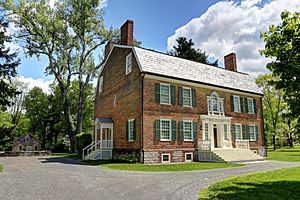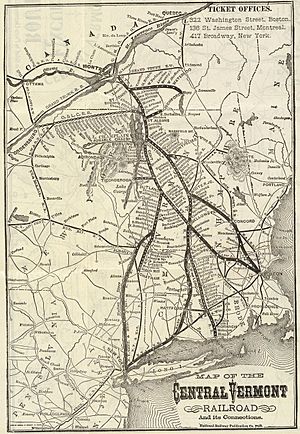Columbia County, New York facts for kids
Quick facts for kids
Columbia County
|
|||
|---|---|---|---|
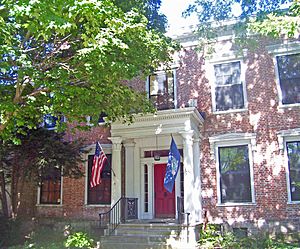
First Columbia County Courthouse in Claverack
|
|||
|
|||
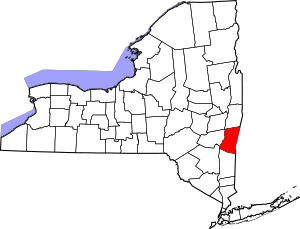
Location within the U.S. state of New York
|
|||
 New York's location within the U.S. |
|||
| Country | |||
| State | |||
| Founded | April 4, 1786 | ||
| Named for | Christopher Columbus | ||
| Seat | Hudson | ||
| Largest city | Kinderhook | ||
| Area | |||
| • Total | 648 sq mi (1,680 km2) | ||
| • Land | 635 sq mi (1,640 km2) | ||
| • Water | 14 sq mi (40 km2) 2.1% | ||
| Population
(2020)
|
|||
| • Total | 61,570 | ||
| • Density | 97/sq mi (37/km2) | ||
| Time zone | UTC−5 (Eastern) | ||
| • Summer (DST) | UTC−4 (EDT) | ||
| Congressional district | 19th | ||
Columbia County is a county in the U.S. state of New York. At the 2020 census, the population was 61,570. The county seat is Hudson. The name comes from the Latin feminine form of the surname of Christopher Columbus, which was at the time of the formation of the county a popular proposal for the name of the United States. The county is part of the Capital District region of the state.
Contents
History
At the arrival of European colonists the area was inhabited by the indigenous Mohican Indians. To the west of the river were the Mohawk and other four tribes of the Iroquois Confederacy, extending past what is now the border of New York state. The first known European exploration of Columbia County was in 1609, when Henry Hudson, an English explorer sailing for the Dutch, ventured up the Hudson River. An accident to his craft forced him to stop at what is now known as Columbia County and there search for food and supplies. In 1612, the Dutch established trading posts and minor settlements, building New Amsterdam (now New York City) and Fort Orange (now Albany). Fort Orange became a center of the fur trade with the Mohawk people. Traders stopped at points along the Hudson River on their travels between New Amsterdam and Fort Orange; small settlements arose along the river to supply the traders' ships.
Dutch colonists bought land [from whom?] near Claverack in 1649 and 1667. As more Dutch arrived, the region slowly developed. In 1664, the English took over New Netherland and renamed it the "Province of New York"; they also renamed Fort Orange "Albany".
In the late 17th century, Robert Livingston, a Scots immigrant by way of Rotterdam, built on his connections as Indian agent in the colony and purchased two large tracts from the Native Americans. He gained much larger grants from the provincial government, for a total of 160,240 acres. He was made lord of Livingston Manor by the Crown, with all its perquisites, and developed the property with tenant farmers. In 1710, he sold 6,000 acres of his property to Queen Anne of Great Britain for use as work camps and for the resettlement of Palatine German refugees. The Crown had supported their passage to New York, and they were to pay off the cost by indentured labor. Some 1,200 Palatine Germans were brought to Livingston Manor (now Germantown). New York's Governor Hunter had also helped with these arrangements: the workers were to make naval stores (e.g., pitch, resin, and turpentine) from the pine trees in the Catskill Mountains.
They were promised land for resettlement after completing their terms of indenture. They were refugees from years of religious fighting along the border with France, as well as crop failures from a severe winter. Work camps were established on both sides of the Hudson River. The Germans quickly established Protestant churches at the heart of their community, which recorded their weddings, births and deaths, among the first vital records kept in the colony.
After many years, some of the colonists were granted land in the frontier of the central Mohawk Valley west of present-day Little Falls in the 100 lots of the Burnetsfield Patent; in the Schoharie Valley, and other areas, such as Palatine Bridge along the Mohawk River west of Schenectady. They were buffer communities between the British settlements and the Iroquois and French (the latter located mostly in Canada.)
Columbia County was formed in 1786 after the American Revolutionary War from portions of Albany County, once a vast area until new communities were developed and jurisdictions were organized. In 1799, the southern boundary of Columbia County was moved southward to include that portion of Livingston Manor located in Dutchess County.
In the nineteenth century, the Vermont Central Railway was constructed to the area. It provided transportation north towards Rutland and Burlington, Vermont, and south towards the major junction town of Chatham, New York, for travel to points west, south and east.
A large number of LGBT artists and writers settled in Columbia County in the late 20th century, including Ellsworth Kelly, who moved to the county in 1970, followed by James Ivory and Ismail Merchant (1975) and the poet John Ashbery (1978).
Geography
According to the U.S. Census Bureau, the county has a total area of 648 square miles (1,680 km2), of which 635 square miles (1,640 km2) is land and 14 square miles (36 km2) (2.1%) is water.
Columbia County is in the southeast south-to-central part of New York State, southeast of Albany and immediately west of the Massachusetts border. The western border is the Hudson River.
The landscapes of the county were among the scenes depicting by the Hudson River School, a mid-19th century art movement.
The terrain is gentle, rolling hills, rising sharply into the Taconic and Berkshire Mountains along the state line. To the west lie the Hudson River and the Catskill Mountains.
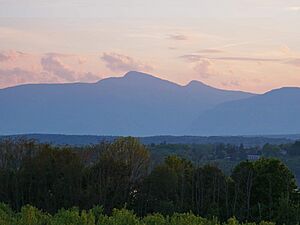
The highest point is on the Massachusetts state line, near the summit of Alander Mountain, at approximately 2,110 feet (640 m) above sea level, in the town of Copake. The lowest point is at or near sea level, along the Hudson.
Columbia County is accessible by two limited-access highways. The Taconic State Parkway, which is not accessible to trucks or commercial traffic, runs through the center of the county from south to north, ending at an interchange with Interstate 90 and connecting the county with points south. Columbia County is the last New York county located along eastbound Interstate 90 (and the first county along westbound I-90), which passes through the towns of Canaan and Chatham as the Berkshire Connector portion of the New York Thruway. I-90 has two exits within the county; for the southbound Taconic State Parkway in Chatham, and for NYS Route 22 in Canaan. Depending on precise location within the county, road travel distance to New York City ranges between 96 and 145 miles (154 and 233 km).
Several other major routes cross Columbia County including north–south U.S. Route 9, east–west NYS Route 23, north–south NYS Route 22 and a short portion of east–west U.S. Route 20 in the county's northeastern corner.
Rivers and streams
The Hudson River forms the western border of the county. Other notable creeks include; the Ancram Creek, Claverack Creek, Copake Creek, Kinderhook Creek, Roeliff-Jansen Kill, and Valatie Kill. The Rossman Falls and Stuyvesant Falls lie on the Kinderhook Creek. Notable lakes and ponds include Copake Lake, Kinderhook Reservoir, Queechy Lake, and Lake Taghkanic.

Farms
Columbia County is home to many local farms supplying the area with fresh meat, eggs, herbs, and produce, including Holmquest, Ronnybrook, Fix Brothers Fruit Farm, Eger Brothers, Hover Farms, Marsh Meadow Farm, Schober Farm, Millerhurst, Ooms Farm, Churchtown Dairy, Pigasso, Common Hands Farm, Darlin' Doe, Blue Star Farm, Green Mead Farm, Little Ghent Farm, and Ironwood Farm. Other farms include the large, well-known Hawthorne Valley Farm which includes a farm store and training programs, the biodynamic Roxbury Farm, and FarmOn! at Empire Farm, also a teaching farm.
Adjacent counties
- Albany County - northwest
- Berkshire County, Massachusetts - east
- Dutchess County - south
- Greene County - west
- Rensselaer County - north
- Ulster County - southwest
National protected area
Demographics
| Historical population | |||
|---|---|---|---|
| Census | Pop. | %± | |
| 1790 | 27,496 | — | |
| 1800 | 35,322 | 28.5% | |
| 1810 | 32,390 | −8.3% | |
| 1820 | 38,330 | 18.3% | |
| 1830 | 39,907 | 4.1% | |
| 1840 | 43,252 | 8.4% | |
| 1850 | 43,073 | −0.4% | |
| 1860 | 47,172 | 9.5% | |
| 1870 | 47,044 | −0.3% | |
| 1880 | 47,928 | 1.9% | |
| 1890 | 46,172 | −3.7% | |
| 1900 | 43,211 | −6.4% | |
| 1910 | 43,658 | 1.0% | |
| 1920 | 38,930 | −10.8% | |
| 1930 | 41,617 | 6.9% | |
| 1940 | 41,464 | −0.4% | |
| 1950 | 43,182 | 4.1% | |
| 1960 | 47,322 | 9.6% | |
| 1970 | 51,519 | 8.9% | |
| 1980 | 59,487 | 15.5% | |
| 1990 | 62,982 | 5.9% | |
| 2000 | 63,094 | 0.2% | |
| 2010 | 63,096 | 0.0% | |
| 2020 | 61,570 | −2.4% | |
| U.S. Decennial Census 1790-1960 1900-1990 1990-2000 2010-2020 |
|||
2020 census
| Race | Num. | Perc. |
|---|---|---|
| White (NH) | 50,795 | 82.5% |
| Black or African American (NH) | 2,421 | 3.93% |
| Native American (NH) | 70 | 0.11% |
| Asian (NH) | 1,423 | 2.31% |
| Pacific Islander (NH) | 16 | 0.02% |
| Other/Mixed (NH) | 3,303 | 5.4% |
| Hispanic or Latino | 3,542 | 5.8% |
Communities
City
- Hudson (county seat)
Towns
Villages
Census-designated places
Hamlets
- Boston Corner
- Chatham Center
- Columbiaville
- Craryville
- East Chatham
- Elizaville
- Humphreysville
- Lebanon Springs
- Malden Bridge
- Mellenville
- New Britain
- New Lebanon
- New Lebanon Center
- Niverville
- North Chatham
- Old Chatham
- Spencertown
- Stuyvesant Falls
- Red Rock
- West Copake
- West Lebanon
Education
- Columbia–Greene Community College is located in Hudson, NY.
Transportation
Major highways
Interstate 90 runs east–west through the county. The Taconic State Parkway runs from I-90 south towards Westchester County. The main arterial north–south road, U.S. 9, runs through the larger towns towards the Hudson River.

 I-90 / Berkshire Connector
I-90 / Berkshire Connector US 9
US 9 US 20
US 20 NY 9G
NY 9G NY 9H
NY 9H NY 9J
NY 9J NY 22
NY 22 NY 23
NY 23 NY 23B
NY 23B NY 66
NY 66 NY 71
NY 71 NY 82
NY 82 NY 203
NY 203 NY 217
NY 217 NY 295
NY 295 NY 344
NY 344 NY 398
NY 398 Taconic State Parkway
Taconic State Parkway
Railroads
Amtrak passenger trains of the Empire Service corridor, as well as the Adirondack, Ethan Allen Express, Maple Leaf and the seasonal Berkshire Flyer make stops at Hudson station.
Into the latter 1930s, the Rutland Railroad (in map above) operated trains between Bennington, Vermont and Chatham. At Chatham Union Station there were connections to New York Central's Harlem Line to Grand Central Terminal. Penn Central (successor to the New York Central) truncated service on the Harlem Line from Chatham to Dover Plains in 1972.
Airport
Columbia County Airport is located in Hudson and provides general aviation services.
Notable people
- Martin van Buren (1782–1862) – the eight President of the United States
- Francis Forshew (1827–1895), photographer
See also
 In Spanish: Condado de Columbia (Nueva York) para niños
In Spanish: Condado de Columbia (Nueva York) para niños




